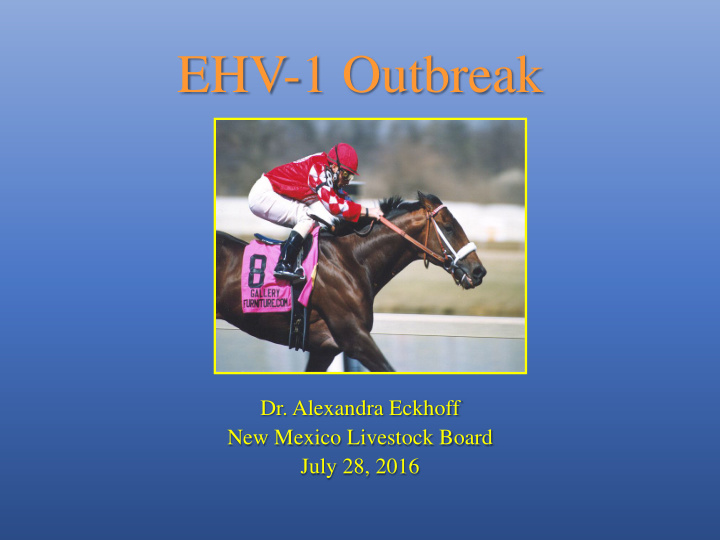



EHV-1 Outbreak Dr. Alexandra Eckhoff New Mexico Livestock Board July 28, 2016
Equine Herpes Virus-1 Viral disease Neuropathogenic Non-neuropathogenic Transmission: direct/indirect Incubation: 2-10 days Clinical signs: Respiratory: fever >102º F (1-7 days), coughing, depression, inappetence, and nasal discharge. Reproductive: abortion (months 7 and 11 of gestation, about 2-12 weeks post-infection). Neurologic: mild incoordination, hindlimb paralysis, recumbency, loss of bladder and tail tone. Diagnosis: PCR nasal swab, whole blood Treatment: supportive
Normal Movement of Animals Horse goes to out-of- state horse show Contact Business as with other usual horses Horses are Horses in contact disperse to with others different in their own states states
Why Issue a Quarantine ? Infected horse goes to out-of- state horse show Contact Epidemic with other horses Horses in First horse contact begins to with show others in clinical their own signs states Horses disperse to different states
Misery Loves Company • Natl. Cutting Horse Association April 29- May 8, 2011 • More than 400 horses exposed in 19 states • 1635 horses at risk for secondary exposure • 90 confirmed cases in 10 states, 13 dead horses • Of the 90 confirmed, 54 had been at show
2016 EHV-1 Outbreak How it all began First confirmed case 1/21/2016 By 1/22/2016, 4 quarantined facilities Approx. 3000 horses under quarantine Diagnosis Clinical signs PCR on whole blood and nasal swabs
2016 EHV-1 Outbreak Establishing a Plan Test and isolate based on clinical signs Fever Neurological signs Isolation barn on site Individual quarantined barns within a quarantine Biosecurity protocols Twice daily temperatures Disinfection PPE
Explaining the Importance of Biosecurity • Highly contagious : aerosol and mechanical transmission • Horse owners and trainers urged to take biosecurity measures • Cleaning and disinfecting surfaces or items horses come in contact with • Controlling foot, vehicle, and pet traffic on the racetrack grounds • Wearing plastic boot covers, sanitizing footwear and clothing
2016 EHV-1 Outbreak Communication No news is not good news Education and outreach to trainers and owners Media communication
EHV-1- Lessons Learned • Clear misconceptions • The disease cannot be explained enough • Should horses train or not? • Swabbing for surveillance testing? • How long is testing necessary? • Quarantine release?
The Cost of EHV-1 Traceability 1632 horses on Sunland Racetrack Approx. 700 horses that had moved or were in adjacent facilities Total tally 73 confirmed positive horses 12 neurologic cases 7/12 recovered Euthanasias 6/11 clinical signs 5/11 owner’s request
New Mexico January 21, 2016-March 9, 2016
The Cost of EHV-1 Personnel NMLB, NMDA, NMSU, ALIRT vets, NM State Police Mileage >13,000 miles >$6,000 in fuel Time Over 1,000 hours worked Over 40 hours of conference calls
The Cost of EHV-1 Testing- NMDA VDS 407 blood samples 413 nasal swabs $36.50/sample ALIRT Vets Deployment of 4 vets Approx.1,000 miles Approx. 60 hrs.
The Stress of EHV-1 On the Animal Side Worst outbreak in New Mexico history Risk to interstate movement On the Human Side Mechanical transmission from human to horse Prevention limit exposure, isolate, avoid contact between sick individuals, biosecurity
What If…? Risk to Interstate Movement Loss of confidence and acceptance of equine imports to other states Risk to the national racing industry Risk to breeding facilities Impediment to any equine events Economic impact to the equine industry and agrotourism Loss of credibility and reputation at a national and international level
Fiscal Impact Agency 508 Costs Related to Sunland Park EHV-1 Quarantine January thru February 2016 Personnel Hours Expense Inspection Staff 1,022 hrs 33,851 Veterinarian Staff 204 hrs 9,458 Administrative 175 10,435 $ 53,744 Staff Travel Per Diem 3,029 $ 3,029 Vehicle Use Mileage 16,765 $ 7,712 Contract Veterinarian Staff Contract Costs 5,747 5,747 NMDA Testing 29,930 29,930 $ 35,677 Supplies Supply Cost 1,079 $ 1,079 Total Expense $ 101,241.00
Questions?
Recommend
More recommend